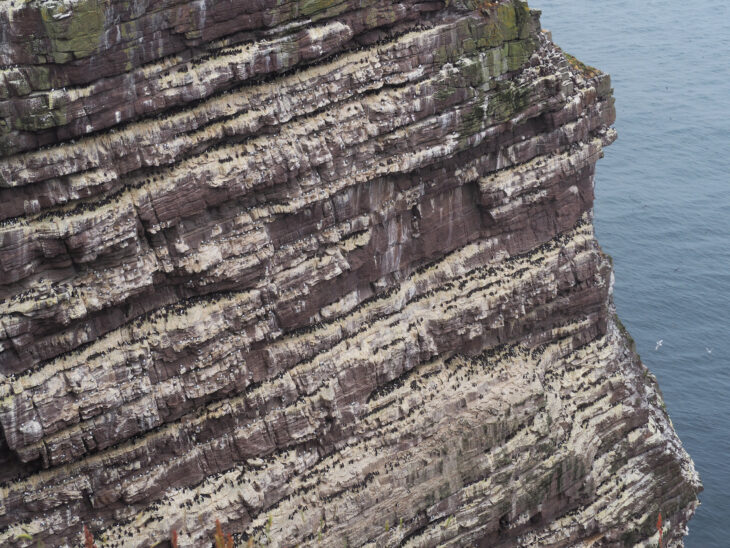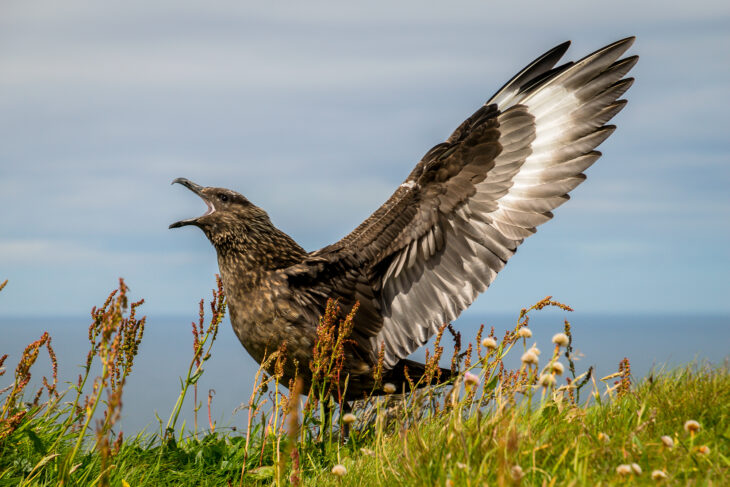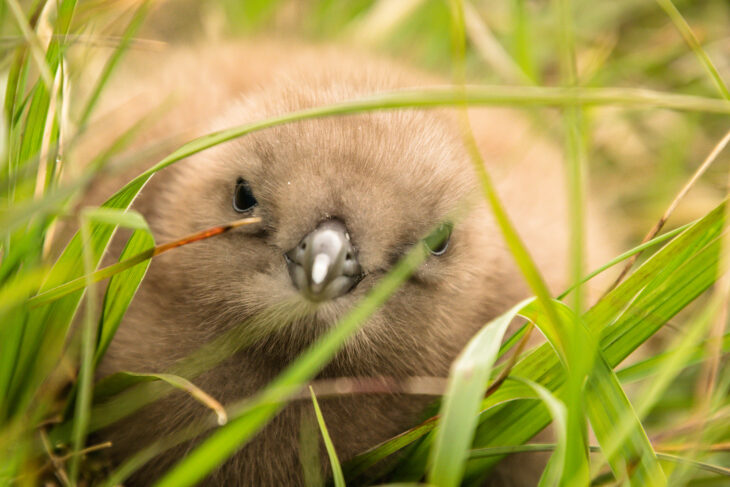Handa Island 2022: A Stormy Season
Sliding through the caramel water of a lochan, the sun picking out the bubbles trapped in hairs on my arms in gold leaf, I looked up to meet the inquisitive dark eye of the first great skua seen above Handa for the season.
The island had been quiet for my first weeks. Not only because the ledges had not yet filled with the raucous auks – mocha and cream guillemots and humbug razorbills – and the skies with hollering great and Arctic skuas. We also just had so few people on the island. Once Rab, the Reserve Manger, and Erika, the previous Ranger, had left following my induction, it was just myself and Phoebe, our Seabird Monitoring Assistant, for more than a week, and without visitors as the ferry had not yet begun operating for the season.
Although there was something magical about the island like this – a feeling of suspended animation and expectation – it was a real joy for Handa to begin to come alive and for the rest of the team of dedicated long-term volunteers (Ellie, our Skua Monitoring Assistant and Annie, our Reserve Assistant) to join us. It didn’t take long for the ledges to erupt with guillemots and razorbills, and for clouds of kittiwakes to join fulmars wheeling in the skies. Great skuas streamed in following our first sighting in March and after weeks of expectant waiting, we finally welcomed the first Arctic skuas in April.

Life on Handa is like twitching aside a veil and catching glimpses of something lost and forgotten. A particular example of this is conducting fieldwork for the long-term Skua Monitoring Project on Handa. I’ve had the privilege to join Ellie while seeking out nests of Arctic skuas so that their fates can be followed, and their productivity measured. Lying flat on beds of heather we watch these careening birds and look out for their signs. With only 20 or so pairs on the island we are getting to know them as individuals, tuning in to their fantastic and sometimes inexplicable behaviour. The veil is twitched but never entirely pulled back – there is still magic in the mystery.
Currently the island teems with life with grouse and snipe chicks scurrying in the grass; tufty wheatear and meadow pipit chicks bouncing on the boardwalk; oystercatcher and ringed plover chicks resembling pompoms on stilts down on the beaches; spotty silvery gull chicks taking their first flappy flights and seabird chicks bursting out of the nests and ledges on the cliffs.
However there has also been a storm cloud over Handa this year. We have not been impervious to the outbreak of avian influenza that has been ripping through populations of seabirds around Scotland, the UK, and the world. Originating in poultry farming the current strain is deadly and highly mutable and seabirds are the unfortunate victims of this lethal outbreak.

Here on Handa it has sadly been the great skuas that have borne the brunt, with our recent all-island census count revealing a 75% decline in great skua territories since the last count in 2018, and colonies around Scotland are reporting the same sad tale. With Scotland sheltering 60% of the breeding population of great skuas, who had already been experiencing declines in many of the larger colonies over previous years, this is a serious situation. It also throws the fragility of our seabirds into sharp relief. Already they had been facing a perfect storm wrought by climate change and other human actions including overfishing and pollution.
The willingness to share and support each other across organisations and great skua colonies around Scotland has been heartening, as the urgent need to monitor and act on the avian influenza outbreak has drawn us together. This crisis has also highlighted the importance of vital conservation efforts and policy decisions into the future that support strong and resilient populations of seabirds.
While the muirland of Handa lies quiet this year, it has remained a great pleasure to observe the life that continues even in the midst of such terrible circumstances. Each great skua chick on the island is now an even more precious discovery. Mostly they are now found while Ellie walks a transect to look out for dead skuas on the island, a rather grimmer task than our Skua Monitoring Assistant normally faces. Counting carcasses rather than the vibrant gorgeous birds that should be soaring over the island, defending and tending to the next generation, has been a painful experience this season.

I was hit hard recently by receiving back information from a ring on a dead great skua that revealed that this bird was born in 1994, making it even older than me – and brought cruelly to an end by this current disaster. It also highlights the danger faced by great skuas and other seabirds as their populations are decimated by avian influenza due to their being long-lived and slow to reach reproductive age, making it harder for populations to ‘bounce back’.
However, great skua parents are still to be found storming around their chicks and nests, diving and driving Ellie from their precious progeny. These proud fierce great skua parents have, in the harshest of circumstances, still created gorgeous creatures full of potential and we are determined not to let that potential be extinguished. Handa may be quietened but we must continue to raise our voices to break that silence and call on actions to support our seabirds through this crisis and a return to noisy, joyous, thriving life.
Molly Harvey
Handa Seasonal Ranger
Help protect Scotland’s wildlife
Our work to save Scotland’s wildlife is made possible thanks to the generosity of our members and supporters.
Join today from just £3 a month to help protect the species you love.
Preface
Sliding through the caramel water of a lochan, the sun picking out the bubbles trapped in hairs on my arms in gold leaf, I looked up to meet the inquisitive …
